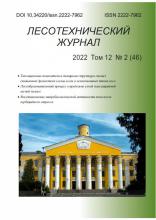Sankt-Peterburg, St. Petersburg, Russian Federation
Sankt-Peterburg, St. Petersburg, Russian Federation
Harvesting of medicinal-plant raw materials is one of the most promising areas for Russian producers, the market of which is characterized as developing one. Research on spatial analysis and definition of biological stock of medicinal-plant raw materials is made on the example of Lisinsky scientific-experimental forestry. The following medicinal plants: lily of the valley (Convallária majalis L.), St. John's wort (Hypéricum perforátum L.), valerian (Valeriána officinális L.), wood sorrel (Óxalis acetosella L.), Labrador tea (Ledum palustre L.), stinging nettle (Urtíca dióica L.) are widespread on the territory of the forestry and have potential commercial value. Data on stocks and territorial location of the medicinal plants were obtained with the use of geoinformation technologies. Biological stocks of medicinal raw materials is defined by the regional table for average long-term yield based on the types of growing conditions, forest types and taxonomic characteristics of plants. If we consider the maximum yield of one specific type of forest, we can say that Labrador tea and stinging nettle has the greatest mass. In the result, it was determined that harvesting of medicinal plants in the territory of forestry is possible for all the considered types of medicinal plants, which will increase the volumes of harvesting and storage of valuable raw materials. Inventory information and location of medicinal plants will enable to optimize the choice of the routes for the priority procurement of raw materials. Using GIS technology the total biological stock of the types of medicinal plants in Lisinsky scientific-experimental forestry was determined. Spatial analysis allowed determining the areas with the highest yield of medicinal plants. Geographic information systems can be used as a tool for monitoring, inventory, protection and organization of the industrial harvesting of medicinal raw materials. The developed technology can be used to determine the yield of mushrooms and wild berries.
geographic information systems, forest resources, medicinal raw materials, medicinal plants, spatial analysis.
1. Alekseev A. S., NikiforovA. A. Effects of Topography on the Structure and Productivity of Forest Landscapes Using 3D Modeling in Terms of the Lisinsky Educational and Experimental Forest Enterprise.Contemporary Problems of Ecology. Springer, 2014, no. 7, pp. 815-826.
2. GrebnerD. L., BettingerP., SiryJ. P.Introduction to Forestry and Natural Resources. Academic PressPubl., 2013, 508 p. DOI: https://doi.org/10.1016/C2010-0-64966-2; EDN: https://elibrary.ru/UPKPOP
3. Maplnfo Professional.User Guide. New York: Pitney Bowes Software Inc.Publ., 2014, 540 p.
4. Qayum, A., LynnA., AryaR. Traditional Knowledge System Based GIS Mapping of Antimalarial Plants: Spatial Distribution Analysis. Journal of Geographic Information System, 2014, no. 6, pp. 478-491.
5. Gerasimov Ju. Ju., Kil'peljajnenS. A., DavydkovG. A. Geoinformacionnye sistemy [Geographic Information systems]. Joensuu, 2001, 201 p. (in Russian).
6. Instrukcija o porjadkesozdanijairazmnozhenijalesnyh kart [Instruction on the order of creation and reproduction of forest maps]. Moscow, 1987, 80 p. (in Russian).
7. Kurlovich L. E.,eds.Rukovodstvo po uchetu I ocenke vtorostepennyh lesnyh resursov I produktov pobochnogo lesopol'zovanija [Guidelines for accounting and evaluation of secondary forest resources and forest by-products]. Moscow, 2003, 316 p. (in Russian). EDN: https://elibrary.ru/QKVTIP
8. ZhukovaA. I.,eds. Lesnoeresursovedenie [Forest resources]. Saint-Petersburg, 2008, 206 p. (in Russian).
9. Lesohozjajstvennyjreglamentuchebno-opytnogolesnichestvaLeningradskojoblasti [Forest management regulations of teaching and experimental forestry Leningrad region]. Saint-Petersburg, 2013, 255 p. (in Russian).
10. Nikiforov A. A. Razrabotka informacionnoj sistemy Lisinskogo UOLH s primeneniem GIS-tehnologij [Development of information system LisinoFES using GIS-technology]. Sbornikdokladovmolodyhuchenyhnaezhegodnojnauchnojkonferencii Sankt-Peterburgskojlesotehnicheskojakademii [Collection of reports of young scientists at the annual scientific conference of the Saint-Petersburg Forestry Academy]. Saint-Petersburg.: SPbFTAPubl., 2002, no. 6, pp. 54-59. (in Russian).
11. Nikiforov A. A.,ZhukovaA. I. Analiz raspredelenija dikorastushhih jagodnikov po tipam lesa na territorii Lisinskogo UOLH s primeneniem GIS-tehnologij [Analysis of distribution of wild berries on the forest types in the territory LisinoFES using GIS-technology].Izvestija Sankt-Peterburgskojlesotehnicheskojakademii [Proceedings of the Saint-Petersburg Forestry Academy], 2010, № 191, pp. 4-13. (in Russian). EDN: https://elibrary.ru/OIOTVX
12. Selihovkin A. V.,eds. Lisino. 200 let sluzhenijalesamRossii [Lisino. 200 years of service to the forests of Russia]. Saint-Petersburg, 2009, 224 p. (in Russian).
13. Cvetkov V. Ja. Geoinformacionnye sistemy I tehnologii [Geographic Information Systems and Technologies]. Moscow: FinansyistatistikaPubl., 1998. - 288 p. (in Russian). EDN: https://elibrary.ru/RQISYL












